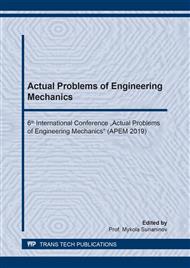[1]
S.M. Anpilov, Опалубочные системы для монолитного строительства". "Formwork systems for monolithic construction,. Moscow, ASV Publ., 2005, 280 p. (in Russian).
Google Scholar
[2]
G.V. Vinogradov, Реология полимеров". "Rheology of polymers,. Moscow, Himiya Publ., 1977, 440 p. (in Russian).
Google Scholar
[3]
R. Lermit, Проблемы технологии бетона". "Concrete Technology Problems,. Moscow, LKI Publ., 296 p.2007. (in Russian).
Google Scholar
[4]
M. Reyner, Деформация, течение. Введение в реологию". "Deformation and flow. Introduction to rheology,. Moscow, Gosstroytehizdat Publ., 1975, 217 p. (in Russian).
Google Scholar
[5]
D.V. Rudenko, Фізико-хімічні закономірності зчеплення між модифікованим бетоном і ковзною опалубкою при зведенні споруд спеціального призначення". "Physico-chemical principles of adhesion between the modified concrete and sliding formwork for the construction of structures of special purposes". Materials of the II International Scientific and Technical Conference "Effective Technologies in Construction,. Kyiv, 2017, pp.170-171 (in Ukrainian).
Google Scholar
[6]
D.V. Rudenko, Бетон на основі дисперсно модифікованої цементної системи". "Concrete based on a dispersedly modified cement system. Science and progress of transport,. Bulletin of the Dnipropetrovsk National University of Railway Transport, 64(4), 2016, pp.169-175. (in Ukrainian).
DOI: 10.15802/stp2016/78008
Google Scholar
[7]
D.V. Rudenko, Дослідження напруженого стану модифікованого монолітного бетону". "Investigation of the stressed state of modified monolithic concrete. Science and progress of transport,. Bulletin of the Dnipropetrovsk National University of Railway Transport, 6, 2016, pp.166-174. (in Ukrainian).
DOI: 10.15802/stp2016/90515
Google Scholar
[8]
N.N. Rudenko, Тяжелые бетоны с высокими эксплуатационными свойствами". "Heavy concrete with high operational properties,. Dnipropetrovsk, Art-Press Publ., 1999, 260 p. (in Russian).
Google Scholar
[9]
V.I. Telichenko, O.M. Terentyev, A.A. Lapidus, Технология возведения зданий и сооружений". "Technology of construction of buildings and structures,. Moscow, Stroyiszdat Publ., 2004, 446 p. (in Russian).
Google Scholar
[10]
M.Sh. Fayner, Высокопрочный бетон". "High-strength concrete,. Chernivtsy, Ruta Publ., 2007, 217 p. (in Russian).
Google Scholar
[11]
A.A. Shubin, J.B. Vysotski, V.G. Pogrebnyak, O.A. Gorban', Физические методы исследования материалов". "Physical methods of materials' research,. Donetsk, Don GUET Publ., 2004, 240 p. (in Russian).
Google Scholar
[12]
V.N. Shmigal'skiy, A.A. Ananenko, I.A. Zhuravleva, Роль фактора времени при формовании бетонных смесей". "The role of the time factor in the molding of concrete mixtures,. Novosibirsk, NIIZhT Publ., 1987, 35 p. (in Russian).
Google Scholar
[13]
P.C. Aitcin, The Art and Science of Durable High-Performance Concrete,. Nelu Spiratos Symposium Committee for the Organization of CANMET/ACI Conferences, 2003, p.69–88.
Google Scholar
[14]
M. Collepardi, Innovative Concretes for Civil Engineering Structures: SCC, HPC and RPC,. Proceedings of the Workshop on New Technologies and Materials in Civil Engineering, 2003, p.1–8.
Google Scholar
[15]
M. Collepardi, The New Concrete,. Published by Grafishe Tintoretto, 2006, 421 p.
Google Scholar
[16]
S. Hanehara, Rheology and early age properties of cement systems,. Cement and Concrete Research, 38(2), 2008, p.175–195. http://dx.doi.org/10.1016/j.cemconres.2007.09.006.
DOI: 10.1016/j.cemconres.2007.09.006
Google Scholar
[17]
O.E. Gjorv, High Strength Concrete,. Advanced in Concrete Technology, 2007, p.21–79. http://dx.doi.org/10.1533/9781845694685.79.
Google Scholar
[18]
B. Middendorf, Nanoscience and nanotechnology in cementing materials,. Cement International, 4, 2006, p.80–86.
Google Scholar
[19]
A.M. Neville, Wlasciwosci betonu,, 4, 2000, 874 p.
Google Scholar
[20]
D. Rudenko, Properties of the phase components of the modified cement system,, TEKA KOMISJI MOTORYZACJI I ENERGETYKI ROLNICTWA, 13(4), 2013, p.218–224.
Google Scholar
[21]
N. Rudenko, The Development of Conception of New Generation Concretes,. TEKA KOMISJI MOTORYZACJI I ENERGETYKI ROLNICTWA, XB, 2010, p.128–133.
Google Scholar
[22]
N. Rudenko, Technology of shotcreting based on activated binder,. TEKA KOMISJI MOTORYZACJI I ENERGETYKI ROLNICTWA, 14(1), 2014, p.222–228.
Google Scholar


